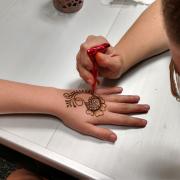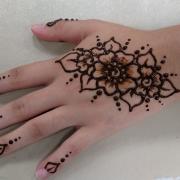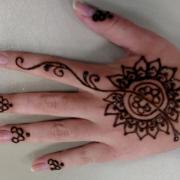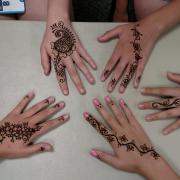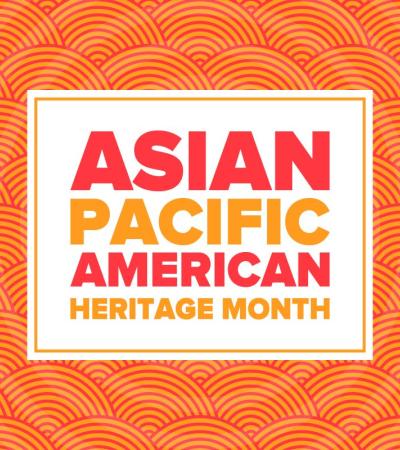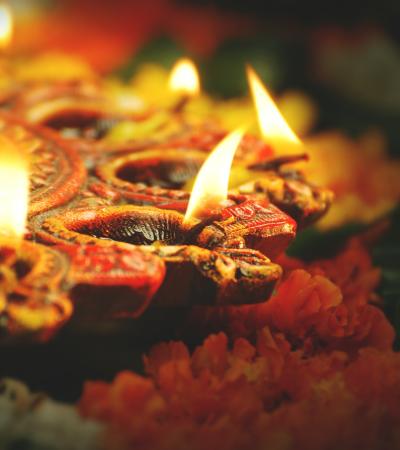Henna, a plant-based dye that safely stains the skin for one to two weeks, is a popular art form among teens. After a brief lecture about henna’s history and tradition and its modern use and safety, the artist gave each participant a unique henna design on the back of his/her hand.
While the teens waited for their turns, they enjoyed traditional Middle Eastern snacks of hummus, pita chips and Medjool dates while watching the Bollywood film "Bride and Prejudice." Books from the library’s collection about the history and art of henna were also available for teens to read.
Advanced Planning
The goal was for the teen participants to learn about the history and significance of henna and leave with a unique henna design on their hands. Recognizing that summer is a busy time for henna artists who participate in weddings, crafts shows and outdoor fairs, planning for this program began three to four months ahead of time.
The teen librarian contacted a henna artist with whom the library had worked with previously. When that henna artist was unavailable, the teen librarian began looking for another local, reputable henna artist. Many henna artists will charge for traveling time if they have to travel far.
After about a week of searching we found Paisley Peacock Body Arts, which is located in a nearby city and led by owner Lauren Grover, who has more than 20 years of experience and has worked with other libraries. A few of those libraries were contacted for reviews prior to contacting the artist.
Marketing
The program was promoted through fliers hung around the library building, a listing on the library’s calendar of events, a listing and more in-depth description on the teen section of the library’s website, an e-newsletter sent three weeks ahead of time to more than 10,000 registered library users and a targeted e-newsletter sent four weeks before the event to 150 teens. (See a program flier under Attachments at right.)
The program was also promoted through word of mouth: the teen librarian talked about it with teens and their parents when they were in the library. Marketing efforts were considered successful because the program was filled to capacity.
Budgeting
The budget for the program was $200. The henna artist was paid $150 for 1.5 hours of her time, which she discounted because it was an educational program and it was scheduled for a weekday. We spent $30 on food and water. To cut costs, the food could be scaled back or eliminated and/or the program could be shortened to one hour. I would not recommend cutting costs by hiring a sub-par henna artist.
Day-of-event Activity
On the day of the event, the library’s custodian set up four tables and 20 chairs for participants to sit and wait their turns, two tables for food and water, a large garbage can and one table and two chairs for the henna artist and the person being hennaed. Just prior to the event, the teen librarian set up the table of food and water, popped the movie into the DVD player, greeted the henna artist and helped her set up her station.
The program was 90 minutes long. The artist suggested allotting four minutes per person, plus five minutes for her presentation at the beginning. During the event, the teen librarian was the only staff person needed.
Program Execution
The teen librarian kept track of the order in which the teens arrived, and that was the order in which they were hennaed. Twenty teens attended, which gave us just enough time to get to each participant. The teens and their parents were all very excited about the high-quality designs created by the henna artist and the variety of programs being presented by the library’s teen department.
After the event, a SurveyMonkey survey was e-mailed to 16 participants. (Some of the attendees were siblings and the contact e-mail address belonged to a parent.) Questions included:
- Overall, how would you rate this event?
- Overall, how would you rate the henna artist?
- Was the program what you expected?
- Do you have any comments about this program?
We received seven responses which rated the program and the artist as very good and excellent. Respondents also stated that the program was better than they expected. One had hoped there would be fewer participants (so she could get a larger henna design), but was happy that the program was full. Additional comments included, “I’m glad the library has programs like this for teens.”
Advice
Make sure you find a reputable henna artist who is willing to tell you where they get their ground henna leaves from and the ingredients they use to make their henna paste. If the ingredients are not all natural or the artist doesn’t want to tell you the ingredients, find another artist. For example, there is no such thing as black henna. Black henna is not natural and could be made from hair dye, which may cause skin irritation and permanent scarring.

